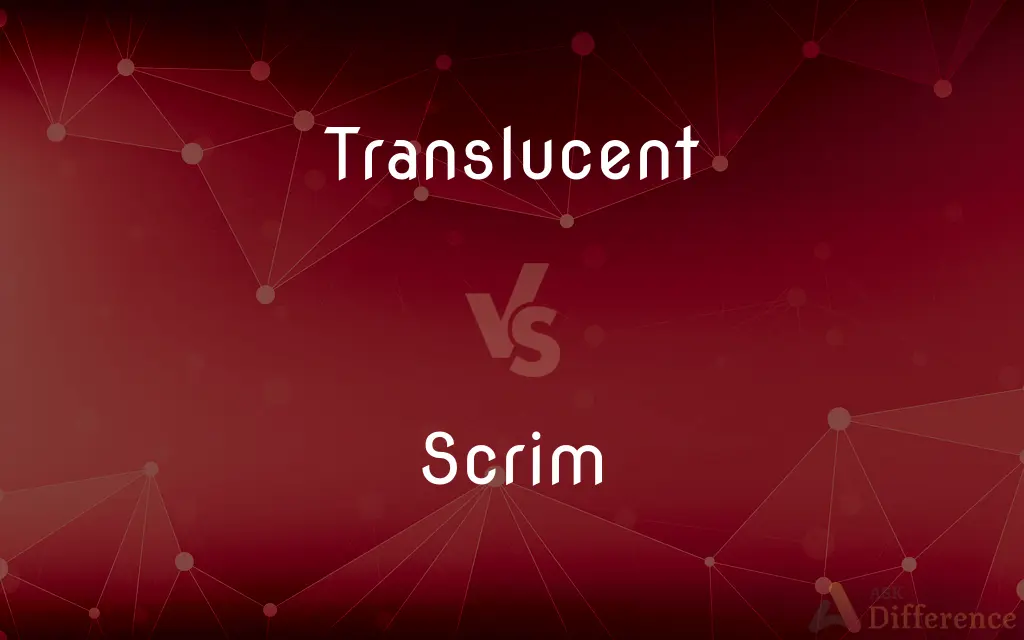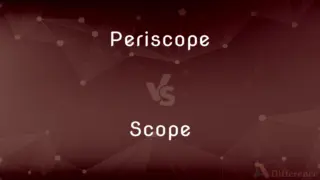Translucent vs. Scrim — What's the Difference?
By Tayyaba Rehman & Fiza Rafique — Updated on May 8, 2024
Translucent materials allow light to pass through diffusely, ensuring some visibility of objects behind them, whereas a scrim, often used in theater, can appear opaque or transparent depending on lighting angles.

Difference Between Translucent and Scrim
Table of Contents
ADVERTISEMENT
Key Differences
Translucent materials partially obscure the visibility of objects behind them by diffusing light as it passes through, offering a softened view. Whereas a scrim, specifically a lightweight fabric used in theater, manipulates visibility and light to dramatic effect.
In terms of usage, translucent materials are commonly used in applications like frosted glass, thin fabrics, and certain plastics where light is desired but complete transparency is not. On the other hand, a scrim's primary use is in theatrical settings to create illusions or reveal scenes through lighting changes.
The effect of a translucent material does not change regardless of the lighting conditions; it consistently diffuses light. In contrast, a scrim can switch from opaque to transparent when the light behind it is brighter than the light in front of it.
Regarding texture, translucent materials can vary widely from smooth and shiny to matte and rough. Scrims, however, are typically made of gauze or a similar mesh-like fabric, designed to be lightweight yet durable enough to handle frequent changes in a stage environment.
From a visual perspective, the aesthetic delivered by translucent materials is generally static, providing a constant degree of obscurity. Scrims offer dynamic visual possibilities, dramatically altering the perception of a scene with strategic lighting.
ADVERTISEMENT
Comparison Chart
Light Transmission
Diffuse, consistent transmission
Changes based on lighting position
Primary Use
Decor, privacy, and lighting
Theatrical effects and scene transitions
Material Variety
Glass, plastic, fabric
Usually lightweight fabrics like gauze
Visibility
Always partially obscures
Can be opaque or transparent
Texture
Varies widely
Typically lightweight and mesh-like
Compare with Definitions
Translucent
Semi-transparent; partially clear.
She wore a blouse made of translucent fabric.
Scrim
A lightweight, mesh-like fabric, often used for backdrops.
The scrim behind the actor made him appear as if floating in space.
Translucent
Often used for both aesthetics and functionality in design.
The architect used translucent panels to enhance natural light inside the building.
Scrim
Integral to stage design and lighting techniques.
Designing the new play involved strategic placement of scrims for visual effects.
Translucent
Allowing light to pass through diffusely but not detailed images.
The translucent curtains diffused the bright sunlight into a soft glow.
Scrim
A piece of fabric used in theater to create lighting effects.
The stage crew lowered a scrim to transition to the dream sequence.
Translucent
Characterized by the ability to see forms or shapes vaguely.
The frost formed a translucent layer on the window.
Scrim
Used in photography and theater for controlling light.
Photographers use scrim to diffuse harsh sunlight during shoots.
Translucent
Not completely opaque; allowing some vision of objects behind.
The translucent shower door offered just enough privacy.
Scrim
A fabric that can appear opaque or transparent depending on the lighting.
The director used a scrim to mysteriously reveal characters on stage.
Translucent
Transmitting light but causing sufficient diffusion to prevent perception of distinct images.
Scrim
A durable, loosely woven fabric, often cotton, linen, hemp, or a synthetic fiber, used for curtains or upholstery lining or in industry.
Translucent
Allowing light to pass through, but diffusing it.
Scrim
A transparent fabric used as a drop in the theater to create special effects of lights or atmosphere.
Translucent
Clear, lucid, or transparent.
Scrim
Something that conceals or obscures something else.
Translucent
Transmitting rays of light without permitting objects to be distinctly seen; partially transparent.
Scrim
A kind of light cotton or linen fabric, often woven in openwork patterns, used for curtains, etc,.
Translucent
Transparent; clear.
Replenished from the cool, translucent springs.
Scrim
A large military scarf, usually camouflage coloured and used for concealment when not used as a scarf.
Translucent
Almost transparent; allowing light to pass through diffusely;
Translucent amber
Semitransparent curtains at the windows
Scrim
A woven, nonwoven or knitted fabric composed of continuous strands of material used for reinforcing or strengthening membranes.
Scrim
(theater) A theater drop that appears opaque when a scene in front is lighted and transparent or translucent when a scene in back is lighted.
Scrim
(photography) A sheet of gauze etc. used to reduce the intensity of light.
Scrim
Thin canvas glued on the inside of panels to prevent shrinking, checking, etc.
Scrim
(online gaming) A practice match between one or more organized teams usually in preparation for a more competitive format, such as a tournament.
Scrim
(photography) To use a scrim.
Scrim
(online gaming) To participate in a scrim.
Scrim
A kind of light cotton or linen fabric, often woven in openwork patterns, - used for curtains, etc,; - called also India scrim.
Scrim
Thin canvas glued on the inside of panels to prevent shrinking, checking, etc.
Scrim
A firm open-weave fabric used for a curtain in the theater
Common Curiosities
What does translucent mean?
Translucent refers to materials that allow light to pass through, but only diffusely, obscuring detailed images.
Can translucent materials be used for privacy?
Yes, translucent materials are often used where privacy is needed but some light passage is desirable, like in bathroom windows.
What are common materials for making scrims?
Scrims are typically made from lightweight, durable fabrics such as gauze or a similar mesh material.
What are the advantages of using translucent materials in architecture?
Translucent materials can enhance aesthetic appeal and natural lighting in buildings without compromising on privacy.
How is a scrim used in theater?
In theater, a scrim is used to create special lighting effects, such as making it appear opaque or transparent to reveal or hide elements on stage.
How does lighting affect the appearance of a scrim?
The appearance of a scrim can change dramatically with lighting; it appears opaque with front lighting and transparent with back lighting.
Are all translucent materials the same in texture?
No, translucent materials can range from smooth and glossy to rough and matte, depending on the type and use of the material.
Is a scrim only used in theater?
While primarily used in theater, scrims are also used in photography and videography to control lighting.
Can scrims be colored or are they always neutral?
Scrims can be dyed different colors, although they are commonly neutral to maximize their versatility in lighting effects.
How do you maintain a scrim?
Maintenance of a scrim involves regular cleaning and careful handling to avoid tears, as they are relatively delicate.
Share Your Discovery

Previous Comparison
Somnolent vs. Stupor
Next Comparison
Periscope vs. ScopeAuthor Spotlight
Written by
Tayyaba RehmanTayyaba Rehman is a distinguished writer, currently serving as a primary contributor to askdifference.com. As a researcher in semantics and etymology, Tayyaba's passion for the complexity of languages and their distinctions has found a perfect home on the platform. Tayyaba delves into the intricacies of language, distinguishing between commonly confused words and phrases, thereby providing clarity for readers worldwide.
Co-written by
Fiza RafiqueFiza Rafique is a skilled content writer at AskDifference.com, where she meticulously refines and enhances written pieces. Drawing from her vast editorial expertise, Fiza ensures clarity, accuracy, and precision in every article. Passionate about language, she continually seeks to elevate the quality of content for readers worldwide.
















































